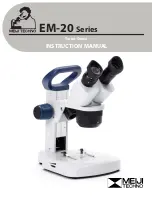
9
A12.0910
★
When replacing the objective, rotate the nosepiece
until it sounds
“
ka-da
”
, to make sure the
objective is in the center of the light path.
2-2-8 Assemble the Eyepiece
(1) Take down the cover of eyepiece tube
①
(See Fig.
9).
(2) Insert the eyepiece into the eyepiece tube, until
touch the bottom.
Note:
if there is position screw on the eyepiece, match
the position screw
②
to the groove
③
on the eyepiece,
and insert the eyepiece into the eyepiece tube, until
touch the bottom.
2-2-9 Connect Power Cord
(1) Make sure the main switch is at “O” (OFF) position.
(2) Match the gap of the lower light source aviation
plug
①
to the gap of the aviation socket
②
, and insert it
to the bottom. (See Fig. 10)
(3) Insert one end of power cord
③
into the power
socket
④
of the microscope.
(4) Insert the other end of power cord into the power
supply socket.
★
Don’t use strong force when the power cord is
bended or twisted, otherwise it will be damaged.
★
Use the special wire supplied by our company. If
it’s lost or damaged, choose one with the same
specifications.
★
Connect the power cord appropriately to make
sure the instrument is connected to ground.
Fig.9
Fig.10













































